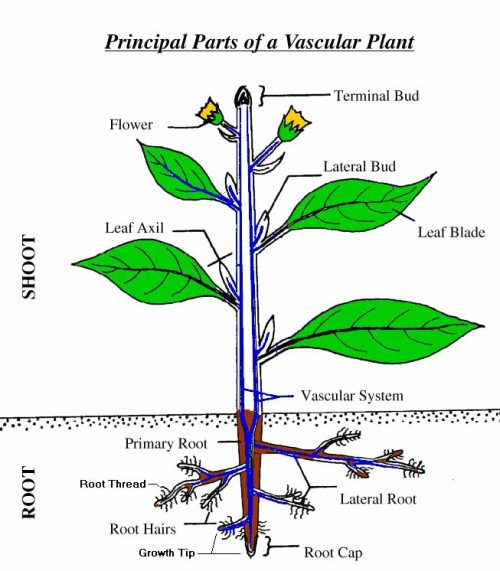Hey, my friend when was the last time you checked your roots?
She gave her plants more light, changed the nutrient solution, and even sang to them, but nothing worked. Why? Her roots were plagued with algae and starving of oxygen, plant roots not the blonde stuff on her head. This becomes our next topic for discussion and is a very important matter.
Regardless of the size of your plant or the species, roots serve the plant in three essential functions:
1. Uptake water and nutrients.
2. Store and manufacture materials needed for plant growth.
3. Give physical support to the plant section growing above-ground.
Aeroponics is all about the roots, that is vibrant healthy roots!
The absorption of nutrients in the water takes place at the tip of very fine root hairs. The nutrients pass through these roots in a selective matter. The root hairs are very delicate and tend to die off as the root grows further into the root zone.
The diffusion process
The method roots use to absorb water and nutrients is called diffusion. This process causes water and oxygen to pass into the root structure through smart membranes in the cell walls of the root. Diffusion actually takes place at the ionic level. Meaning that the nutritional elements are absorbed by the exchange of electrically charged particles.
Maybe this might be the first time you heard of this, but roots need oxygen. They absorb the oxygen and utilize it for growth, in return carbon dioxide is expelled. If oxygen is not present, the roots will asphyxiate or suffocate to death. This leads to root damage and will adversely hurt the tops of your plants. Wouldn’t you feel sick if someone tied your legs in a tourniquet?
Many studies have proven that oxygenation to the root zone is a major factor in determining a plant’s growth potential. This is why the method of Aeroponics was developed to maximize growth leaps beyond the conventionally soil and steps beyond hydroponics. Yep, aeroponics rule over hydroponics. As we all know, plants grown aeroponically have their roots suspended in thin air! All the power to you baby.
Hydroponics could drown your plant roots
Since we brought up a distant cousin of aeroponics, hydroponics can have problems of stagnation of water in the root zone which causes asphyxiation. Next will come root rot. Once a plant’s root becomes sick or dehydrated, death to the organism is usually imminent.
Roots – Please keep me in the dark and wet
Roots should not be exposed to much light. Exposure to light can promote the growth of green algae. Algae appear as a green or brown slime on the roots, on the container, and on any tubing. Studies have concluded that plants suffer when the roots are exposed to light. This is probably due to the algae growth on the surface of the roots.
Algae won’t just suffocate your roots but will also compete for the water and the nutrients in the root zone.
Therefore, only opaque containers should be used to house the plant roots. Black, green or blue work best for tubing and the reservoir. Remember, roots grow naturally into the dark earth and never see the light of day. We need to respect this if we want our plants to be successful.

Roots – Hey, be careful with me
Plant roots are very delicate and should not be handled. If you need to handle your plant, please be gentle and keep the roots wet.
In the event that the roots begin to obstruct your misters or tubing or other components in the root zone, you may have no choice but to adjust their position. Your last resort is to trim back the roots.
Roots – It’s time for a haircut
Most plants will tolerate simple root trimming. You will want to do most of your root cutting on the smaller thread roots, not the larger tap roots. The tap roots will be the larger roots and the thread roots will be the smaller roots that grow off the tap roots.
All you have to do is take the plant and pull the tap roots apart, removing no more than a third of the thread roots in the process. You shouldn’t shorten the tap roots at all during this process, but using clippers to trim the thread roots is acceptable. Also, prune roots that are dead looking away from the plant.
One thing you should know is that root growth occurs at the very tip of the tap and thread roots. If you want to encourage lateral root growth, clip root tips going vertical. Vice versa to encourage vertical root growth, clip the root tips going lateral, but no more that a third at a time.
Healthy Aeroponic roots are:
Three simple indications will reveal if the roots are healthy or sick:
1. Visual Indications – Healthy roots appear full and white in color with many fine hairy tips. As plants mature, you might see it turn a faded yellow. This is normal to a degree.
2. pH Measurement – If the pH is off, your roots won’t be happy. A pH of 5.5 to 6.5 is generally considered an ideal range for most plants. A pH of 7.0 is neutral.
3. PPM measurement – Too much or too little food is no good either. The PPM of your nutrient solution can range from about 800 for crops like lettuce under low light to 1600 for tomatoes under low intense light and supplemental CO2.
In conclusion the plant roots…
In conclusion, it’s important to maintain sufficient humidity around the roots at all times with proper misting cycles. Low humidity in the root zone will cause dehydration, and root die back. Dead roots are visible in the form of being dark and brown. Keep the nutrient pH around 6.0. Once roots are dead, there is no way to revive them so trim them with sharp clippers. Remember if root damage is serious, your crop stands a slim chance of surviving.

